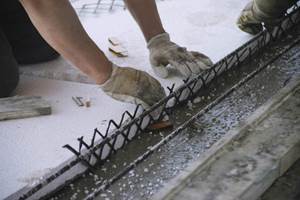PES additive boosts resistance to fracture and micro-cracking in epoxy composites
Often used by the aerospace industry for prepreg and resin-transfer molded carbon fiber-reinforced epoxy, the additive is gaining ground in epoxy composites for automotive and other markets.
A polyethersulfone (PES) micro-powder additive called SumikaExcel 5003P, is said to boost fracture toughness and resistance to micro-cracking for fiber-reinforced epoxy composites over a broad temperature range without negatively impacting dimensional stability, flame/smoke/toxicity (FST), creep resistance, modulus, impact, or yield strength. The functional additive is widely used by the aerospace industry for prepreg and resin-transfer molded carbon fiber-reinforced epoxy, is gaining ground in epoxy composites for automotive, and could be used for high-performance sporting goods as well. The material is produced by Sumitomo Chemical Co. Ltd. (Tokyo, Japan) and is sold in North America by Sumitomo Chemical Advanced Technologies, LLC (Phoenix, AZ, US), which will exhibit at the Composites & Advanced Materials Expo (CAMX) from October 16-18 in Dallas, TX, US.
PES is an amber-transparent, amorphous engineering thermoplastic known for its high temperature capabilities, high strength and impact resistance, good creep resistance at elevated temperatures and loads, good dimensional stability, low coefficient of linear thermal expansion (CLTE) over a broad temperature range, inherent flame retardance, low smoke, minimal outgasing, good and broad chemical resistance, and resistance to hot water (to 180°C). It is offered pelletized for injection molding, extrusion and film processes and in powder form for cast films, filtration membranes, and as an epoxy additive for composites, high-temperature paints and coatings and adhesives. PES grades are used in the aerospace, automotive, electrical/electronics, medical-device and food-handling industries.
In its role as a functional additive for epoxy composites, specific grades with hydroxyl (-OH) end groups are used. The end groups react with glycidyl groups on the epoxy matrix to form a cross-linked, interpenetrating polymer network (IPN). Even though the additive is typically used at low letdown ratios of 2-12 wt-%, it adds greater flexibility to the IPN, which in turn boosts the toughness of the epoxy composite. SumikaExcel 5003P has a glass-transition temperature (Tg) of 230°C, which is higher than that typical of aerospace-grade epoxy resins (ranging from 120-200°C), and since it also has good stiffness and strength, it improves impact and crack resistance without compromising other thermo-mechanical properties. Especially important for aerospace applications, it does all this without affecting FST or the ability to mold and hold very-tight tolerances. Although it is most commonly used with high-performance carbon fiber-reinforced epoxy composites, it is equally effective in glass- or basalt-reinforced epoxy composites too.
Sumitomo Chemical is unique in the plastics industry as the world’s sole PES manufacturer that maintains dedicated PES polymerization facilities (in Chiba and Ehime, Japan) and also a dedicated micro-level powder grinding facility (in Phoenix, AZ, US). This eliminates the possibility of cross-contamination with other polymers — a critical and highly enforced requirement in the aerospace industry — and also simplifies the supply chain for processors and OEMs. Powders as fine as 30 µm and as large as 500 µm are produced at the Phoenix facility using rotary-classifier grinding mills, which are more efficient and accurate than conventional grinding units. Additionally, laser-diffraction characterization equipment is used to measure particle size in both incoming feedstock and outgoing finished powder, and an inductively coupled plasma device checks every lot for metals before and after grinding operations to ensure that the product meets specification requirements.
Related Content
Composites manufacturing for general aviation aircraft
General aviation, certified and experimental, has increasingly embraced composites over the decades, a path further driven by leveraged innovation in materials and processes and the evolving AAM market.
Read MorePlant tour: Airbus, Illescas, Spain
Airbus’ Illescas facility, featuring highly automated composites processes for the A350 lower wing cover and one-piece Section 19 fuselage barrels, works toward production ramp-ups and next-generation aircraft.
Read MoreNanopoxy, Nione jointly develop nanostructured epoxy resin
Epoxies featuring nanometric niobium pentoxide particles promote toughness, UV radiation resistance and other performance gains.
Read MoreComposites-reinforced concrete for sustainable data center construction
Metromont’s C-GRID-reinforced insulated precast concrete’s high strength, durability, light weight and ease of installation improve data center performance, construction time and sustainability.
Read MoreRead Next
All-recycled, needle-punched nonwoven CFRP slashes carbon footprint of Formula 2 seat
Dallara and Tenowo collaborate to produce a race-ready Formula 2 seat using recycled carbon fiber, reducing CO2 emissions by 97.5% compared to virgin materials.
Read MoreVIDEO: High-volume processing for fiberglass components
Cannon Ergos, a company specializing in high-ton presses and equipment for composites fabrication and plastics processing, displayed automotive and industrial components at CAMX 2024.
Read MoreDeveloping bonded composite repair for ships, offshore units
Bureau Veritas and industry partners issue guidelines and pave the way for certification via StrengthBond Offshore project.
Read More












.jpg;maxWidth=300;quality=90)










